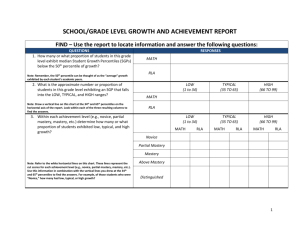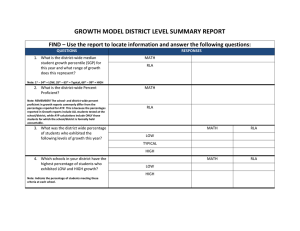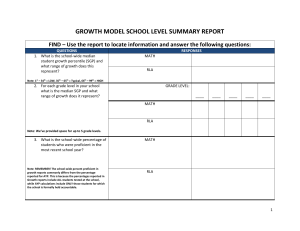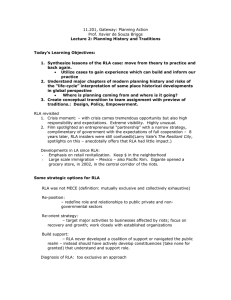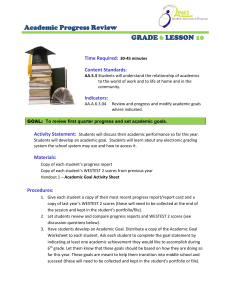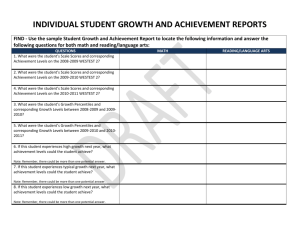DISTRICT LEVEL GROWTH AND ACHIEVEMENT REPORTS FIND
advertisement
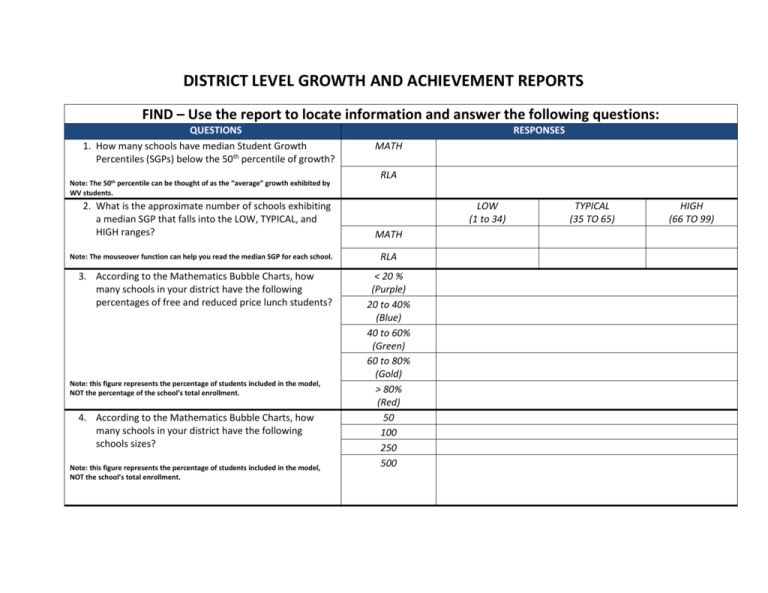
DISTRICT LEVEL GROWTH AND ACHIEVEMENT REPORTS FIND – Use the report to locate information and answer the following questions: QUESTIONS 1. How many schools have median Student Growth Percentiles (SGPs) below the 50th percentile of growth? Note: The 50th percentile can be thought of as the “average” growth exhibited by WV students. 2. What is the approximate number of schools exhibiting a median SGP that falls into the LOW, TYPICAL, and HIGH ranges? Note: The mouseover function can help you read the median SGP for each school. 3. According to the Mathematics Bubble Charts, how many schools in your district have the following percentages of free and reduced price lunch students? Note: this figure represents the percentage of students included in the model, NOT the percentage of the school’s total enrollment. 4. According to the Mathematics Bubble Charts, how many schools in your district have the following schools sizes? Note: this figure represents the percentage of students included in the model, NOT the school’s total enrollment. RESPONSES MATH RLA LOW (1 to 34) MATH RLA < 20 % (Purple) 20 to 40% (Blue) 40 to 60% (Green) 60 to 80% (Gold) > 80% (Red) 50 100 250 500 TYPICAL (35 TO 65) HIGH (66 TO 99) FIND – Use the report to locate information and answer the following questions: 5. Using the mouseover function in the PDF chart, identify the highest and lowest growth schools in your district. LOWEST GROWTH HIGHEST GROWTH MATH RLA Note: Growth is plotted from low to high, horizontally. 6. Using the mouseover function in the PDF Chart, identify the following information for the lowest and highest growth schools in your district. MEDIAN MATH SGP # with MATH SGPs MEDIAN RLA SGP Number with RLA SGPs LOWEST GROWTH SCHOOL HIGHEST GROWTH SCHOOL Note: Adobe’s mouseover function is not supported on iPad because iPad does not have a mouse. 7. Using the mouseover function in the PDF chart, identify the highest and lowest achieving school in your district. Note: Achievement is plotted from low to high, vertically. 8. Using the mouseover function in the PDF Chart, identify the following information for the lowest and highest achieving schools in your district. Note: It is common for the number of students tested in a given content area to differ from the number for which growth data are available. Also, the schoolwide percent proficient commonly differs from the percentage reported for AYP. This is because the percentages reported in the Bubble charts include ALL students tested at the school, while AYP calculations include ONLY those students for which the school is formally held accountable. LOWEST ACHIEVING HIGHEST ACHIEVING MATH RLA % Proficient MATH LOWEST ACHIEVING SCHOOL HIGHEST ACHIEVING SCHOOL # Tested MATH %Proficient RLA # Tested RLA ANALYZE AND INTERPRET: Use what you have discovered to answer the following questions: QUESTIONS RESPONSES 1. Divide the Math and Reading/Language Arts bubble charts into four quadrants by drawing a horizontal line at the 50% Proficient mark and a vertical line at the 50th growth percentile. How many schools fall into each quadrant? HIGHER HIGHER ACHIEVEMENT ACHIEVEMENT LOWER GROWTH HIGHER GROWTH (Top Left) (Top Right) LOWER GROWTH HIGHER GROWTH LOWER LOWER ACHIEVEMENT ACHIEVEMENT (Bottom Left) (Bottom Right) MATH RLA Note: The quadrant labels can be seen in white text on the bubble chart. 2. Navigate to the last chart in your packet (where you can see all the schools broken out by the percentage of students eligible for free and reduced price lunch. Divide this chart into quadrants using the method above. How do the low SES schools tend to fare in growth vs. the higher SES schools? How does this relationship change when you examine achievement? Note: Start by determining if there are more Low SES schools exhibiting low growth or low achievement than higher SES schools GROWTH MATH RLA ACHIEVEMENT FIND – Use the report to locate information and answer the following questions: 3. How would you prioritize support services to schools in your district based upon their position in these quadrants? HIGHER ACHIEVEMENT & LOWER GROWTH (TOP LEFT) HIGHER ACHIEVEMENT & HIGHER GROWTH (TOP RIGHT) LOWER GROWTH & LOWER ACHIEVEMENT (BOTTOM LEFT) HIGHER GROWTH & LOWER ACHIEVEMENT Note: Consider the level of priority you would assign to each quadrant (e.g., 1st, 2nd, 3rd, 4th). Also consider what services you might provide to each quadrant based upon this information. (BOTTOM RIGHT) PLAN NEXT STEPS: Now that you know something about the growth that has occurred in your district this past year, where can you go to get more information? RESOURCES/DESCRIPTION Growth Model District Level Summary Report: This report, available to certain users via the WVDE NCLB private site, presents summary level growth information for the state, the selected district, and all schools within that district for which growth data are available. The report includes the number and percentage of students who achieved low, typical, and high growth as well as the median growth percentile for the state, county, and each school and the percentage of students who achieved proficiency. Each school name is clickable for further drill down to the available school level reports. These data are available for mathematics and reading/language arts. Growth Model School Level Summary Report: This report, available via the WVDE NCLB private site, presents summary level growth information for a selected school. The report presents the number and percentage of students within the school who achieved low, typical, and high growth as well as the median growth percentile for the school and the percentage of students who achieved proficiency. These data are provided for the all subgroup and disaggregated by grade level. County and state data are also presented for comparison purposes. The report contains a number of clickable links: (1) school level keeping up/catching up status report, (2) growth model school level summary data disaggregated by subgroups, (3) a graphical representation of the growth model school level summary report, and (4) links to the available “Grade Level Growth and Achievement Reports.” These data are provided for mathematics and reading/language arts. QUESTIONS What rates of growth are being observed in our district and how do school level growth data relate to the district as a whole? To the state? RESPONSE Growth Model District Keeping Up/Catching Up Status Report: This report, also available only to certain users via the WVDE NCLB private site, presents additional summary level growth information for the state, the selected district, and all schools within that district for which growth data are available. Specifically, the report shows the number and percentage of students projected to “catch up” or “keep up” with proficiency expectations based upon their observed growth and the model’s estimate regarding the level of growth that is necessary for the student to reach or maintain proficiency within a defined period of time. Each school name is clickable for further drill down to similar reports at the school level. How many students in our district are projected to “catch up” to proficiency expectations if they maintain their current growth? How many are projected to “keep up” with these expectations if they maintain their current growth? What schools have large percentages in either category? Growth Model School Level Keeping Up/Catching Up Status Report: This report, available via the WVDE NCLB private site, presents additional summary level growth information for the selected school. Specifically, the report shows the number and percentage of students projected to “catch up” or “keep up” with proficiency expectations based upon their observed growth and the model’s estimate regarding the level of growth that is necessary for the student to reach or maintain proficiency within a defined period of time. This information is provided for all students and disaggregated by grade. A clickable link provides keep up/catch up information for students in the school disaggregated by subgroup. Grade Level Growth and Achievement Report: This report, available for both mathematics and reading/language arts for each grade level where growth data are available, illustrates the growth and achievement levels of all students in a given grade within a single school. Current year achievement for each student (scale score and achievement level) is plotted on the vertical axis and observed growth (SGP) on the horizontal axis. Mouseover functionality in the PDF file displays each student’s name as well as their observed SGP, target SGP, scale score, and corresponding achievement level for the most recent academic year. How is growth distributed within each grade level? What is the relationship between growth and achievement within each grade level band? Electronic Confidential Summary Report (eCSR): This report, accessible via What specific content standards the WVDE NCLB private site, provides summary academic achievement are priorities in our district or in data for a selected grade level within a selected school. The report individual schools? provides the number of students tested and the distribution of students disaggregated by academic achievement level. The report also provides the mean scale score for the grade and aggregated numbers and percentages of students who were assessed “at or above mastery” or “below mastery” expectations. These data are presented for all students as well as disaggregated by subgroup. County and state data are provided for comparison. Further, the report provides school level summary information about all students’ mastery of grade level content standards. WESTEST 2 Content Standards and Objectives Analysis Report (WESTEST 2/CSO Analysis): This report, accessible via the WVDE NCLB private site, provides summary academic achievement data for a selected grade level within the selected school. Users can examine student performance on the WESTEST 2 by content standard. The number of items tested for each content standard, the average number of correct responses, and the percentage correct are displayed. Data are accessible for each content area, grade, and subgroup and school, district and state results are provided for comparison.
